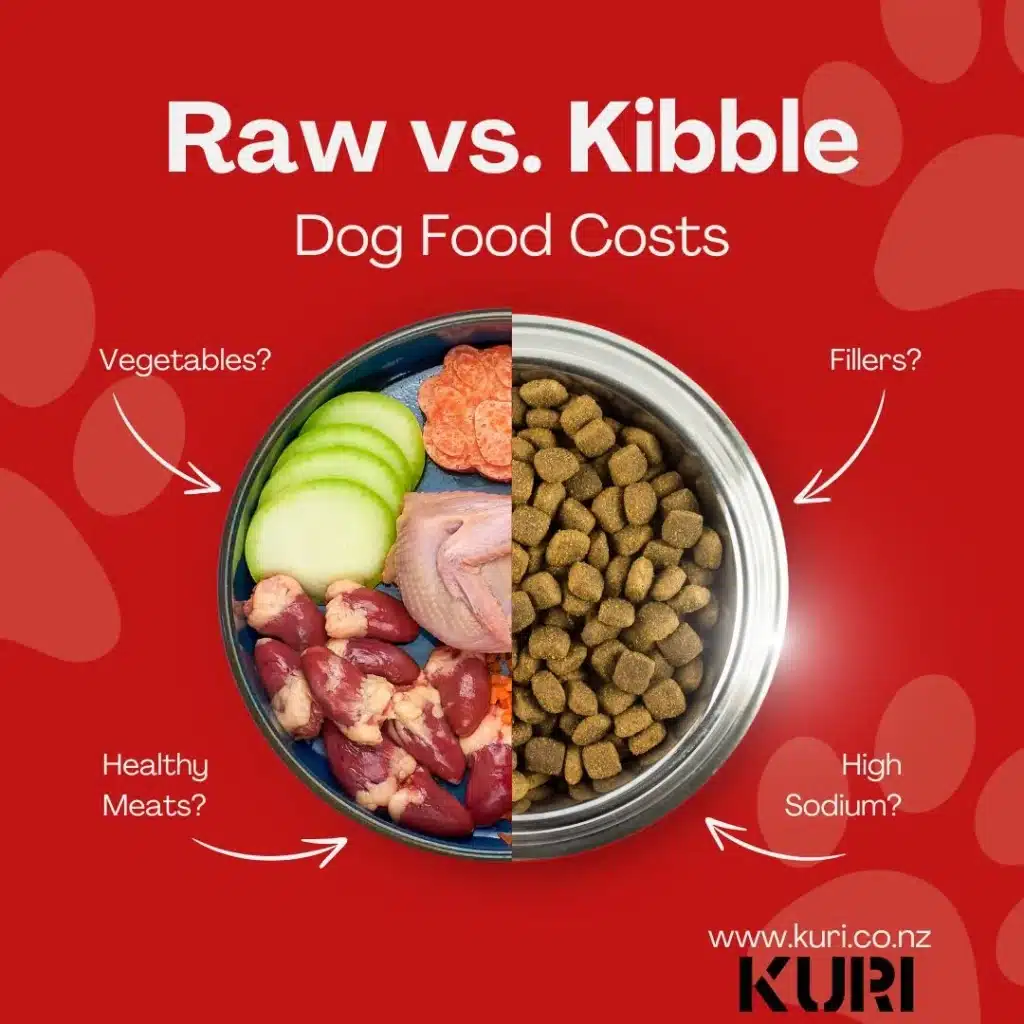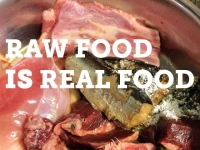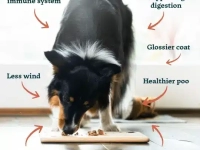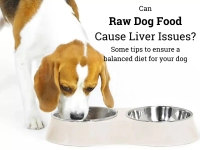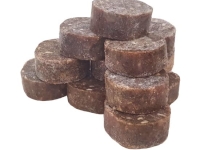In This Article...
THE OVERVIEW...
Dog Food Costs: Raw Food vs. Kibble – A Comprehensive Cost Comparison
Raw vs. Kibble: What’s Actually Cheaper in the Long Run?
Feeding your dog isn’t just about price-it’s about health, behaviour, and what you’ll spend at the vet later. We’re breaking down raw vs. kibble so you can decide what makes sense for your dog and your wallet.
How Much Does Dog Food Really Cost?
How Much Does Kibble Cost Per Kilogram?
Kibble is the go-to for many dog owners because it’s easy and looks cheap. You’ll find bags priced anywhere between $7 and $35 per kilo, depending on brand and quality. Feeding a medium-sized dog might cost you $2.50 to over $5 a day. But here’s the catch: cheap kibble often means cheap ingredients-fillers, by-products, and additives that do nothing good for your dog. That low price? It can come back around in vet bills.
High-end kibble can offer better digestibility and a higher standard of nutrition. You’ll find those between $15 to $35 per kilo. So while you might pay more per bag, you could be feeding less and seeing better outcomes. Still, it’s all processed. It’s dry, often grain-heavy, and stripped of the moisture and live nutrients that dogs thrive on. Look at the back of the bag. If the ingredients list reads like a chemistry set, you already know.
What’s the Cost of Raw Dog Food?
Raw dog food ranges from $5 to $15 per kilo depending on how it’s made and where it’s sourced. Commercial raw-like what we offer at Kuri-is prepped, portioned, and balanced. That means it’s made to meet your dog’s needs without the guesswork.
Feeding a medium-sized dog raw might cost you $2 to $6 a day. That’s often similar to premium kibble. The difference? You’re getting whole meat, organs, and bone, not pellets made from meal and grains. Yes, you might pay more upfront than you would for cheap kibble, but your dog will likely need fewer vet visits, have better digestion, and generally feel better in their body.
Raw feeding can come with add-ons-like supplements, time spent prepping food, or freezer space-but many owners find the trade-off worth it. Your dog gets real food. You get fewer surprises at the vet.
Is Raw Dog Food Actually Better Than Kibble?
What Are the Benefits of a Raw Dog Food Diet?
Raw food is real food. You’re feeding muscle meat, organs, bones, and sometimes veges-not industrial pellets. That makes a huge difference.
Dogs fed raw diets often show big changes in energy, coat condition, and digestion. You’ll see shinier fur, smaller poos, and more enthusiasm at mealtimes. Plus, raw food skips the fillers and additives found in most kibble. No weird colours, no preservatives, no guesswork.
One big win? Flexibility. You can rotate proteins, adjust meals, and respond to your dog’s health and preferences. If your dog’s skin flares up with chicken, you try lamb. If they’re bored, you swap in tripe. You’re not stuck with the same bag for a month.
Yes, it can take a bit of learning. But once you’re in the rhythm, it’s straightforward-and worth it for a dog that’s thriving, not just surviving. Check out our guide to transitioning here
How Does Kibble Compare to Raw Dog Food in Nutritional Value?
Some kibble is decent. But a lot of it is just carbs and fillers with synthetic vitamins sprayed on after cooking. The problem isn’t just what’s in kibble-it’s what’s missing. Moisture. Fresh enzymes. Bioavailable nutrients. All of that gets destroyed during high-heat processing.
Raw food, on the other hand, gives your dog nutrition that’s closer to what their body actually wants. It’s easier to digest, richer in natural fats and proteins, and more hydrating. You don’t need to rely on synthetic add-ons because the nutrients are already there-in the food itself.
That said, balance matters. A good raw diet must be complete. If you’re DIY-ing it, you need to know what you’re doing. Commercial raw (like Kuri’s) is balanced for you, so your dog gets what they need without you needing to become a canine nutritionist.
What Happens When You Switch Your Dog to Raw Food?
Dog owners who switch to raw usually see changes fast. Their dog’s energy spikes. They’re keener to eat. Their coat looks better. Their breath improves. Their poos get smaller and less stinky.
They also get excited for meals. Dogs that used to graze over kibble bowls suddenly wolf down their food. It’s real. It smells good to them. It feels right.
Are there hiccups? Sometimes. You might see softer poos during transition. Some dogs are picky at first. But that’s part of the shift. You’re undoing years of habit and processed food. Stick with it, and most dogs adjust within a few days to a couple of weeks.
Is Raw Dog Food Worth It?
How Does the Cost to Feed Raw Compare to Kibble?
Yes, raw looks more expensive per kilo. But that’s not the full picture. What are you actually paying for?
Kibble might be cheaper, but if it’s causing allergies, ear infections, or constant itching-you’re spending that money at the vet. A raw-fed dog, in good shape, may end up saving you more over time.
You also control the variety. Want to save money? Use more economical proteins. Buy in bulk. Stick to frozen, not freeze-dried. You’re not locked into a bag-you get to make it work for your budget.
Will I Save on Vet Bills with Raw Food?
Dog owners feeding raw often report fewer ear infections, less scratching, better teeth, and calmer tummies. That means fewer emergency visits, less medication, and more predictable monthly costs.
Kibble-fed dogs, especially those on cheaper brands, can end up with gut issues, dental disease, or joint problems-all of which rack up costs later. So yes, raw food is an investment-but one that could actually cost less long-term.
How Do Different Brands Affect Dog Food Prices?
Brand matters-but not in the way advertising tells you.
Some big-name kibbles charge premium prices for fancy packaging, but inside? You’re still getting meal, grains, and additives. Others use better ingredients but come with a steep markup. Read the labels. If meat isn’t the first ingredient, move on.
Raw brands vary too. You’ll pay more for freeze-dried or organic. You’ll save with frozen and pre-portioned meals. Look for transparency in sourcing, and check whether the food meets actual nutritional standards-not just marketing claims.
Try Our Cost Calculator
Feeding raw isn’t about being fancy-it’s about feeding what works. Use our food cost calculator to compare what you’re spending now to what you’d spend feeding Kuri Raw. You’ll see the numbers-and what those dollars are really doing for your dog.
How to Transition Your Dog to a Raw Food Diet
What Steps Should You Follow to Switch from Kibble to Raw?
Start slow. For the first few days, feed 25% raw and 75% kibble. Then go to 50/50. Then 75/25. After a week or two, you’ll be at 100% raw. If things go smoothly, go faster. If not, go slower.
Watch your dog’s poos. If they’re loose, pause. Hold steady. Let their gut adjust. Don’t panic.
We recommend starting with Green Tripe-it helps balance the gut microbiome and makes raw easier to digest.
Some people skip the mix and go straight to raw. That can work too, especially with younger dogs. But be ready to monitor things more closely.
How Long Does It Take for Dogs to Adjust to New Food?
Some dogs adjust in a few days. Others take a few weeks. Dogs that have been on kibble for years might need more time to get used to real food again.
Younger dogs and puppies often switch easily. Older dogs may be slower. Watch behaviour, appetite, and digestion. And if you’re ever unsure, check in with your vet or a pet nutritionist.
What Signs Indicate Your Dog is Adjusting Well?
You’ll know it’s working when:
-
Meals disappear fast.
-
Energy levels are steady and high.
-
Coat looks shinier.
-
Poo is small and firm.
-
Your dog seems satisfied-not hungry, not sluggish.
Dogs fed raw often look more alive. Their bodies work better. Their eyes are brighter. And you stop wondering if their food is actually doing what it’s meant to.
Why Kuri Should Be Your First Choice for Raw Dog Food
At Kuri, we feed dogs like they matter-because they do.
No fillers. No junk. Just raw food made with real meat, bones, and organs. Prepped for convenience. Balanced for health. Backed by people who feed it to their own dogs every day.
We portion our meals into easy 90g blocks. You take what you need, defrost it, and feed. No mess. No waste. Just real food, ready to go.
We offer a mix of proteins so your dog gets variety and balance. Lamb. Chicken. Tripe. Beef. No grains. No artificial anything.
We’re transparent about what’s in the food and why. Because you deserve to know. And your dog deserves better.
Kuri is for people who want to feed their dogs real food. Without stress. Without guessing. Just better health in a bowl.


